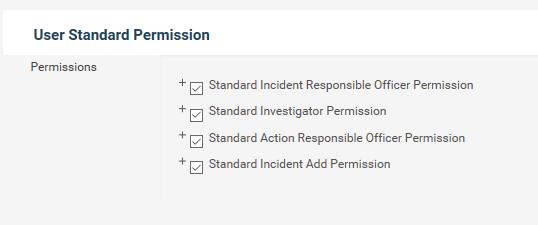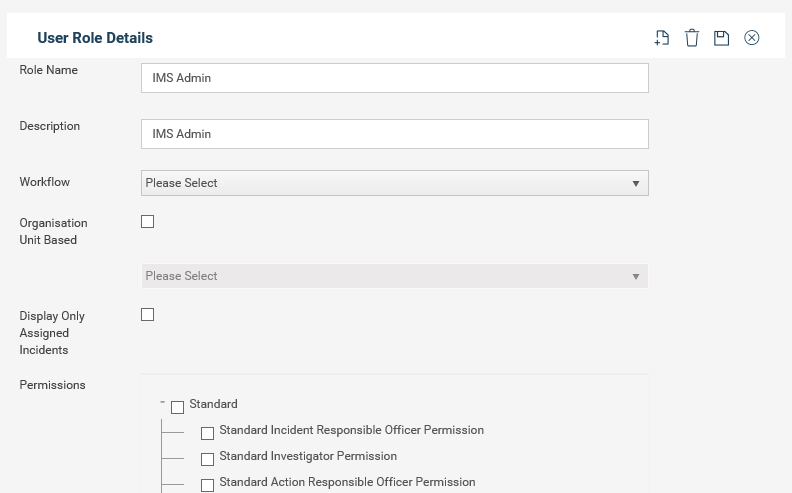
The following permissions are available.
Select permissions.
Standard permissions
Standard incident responsible officer permission: This permission will be provided to all users who will be selected as responsible officers for incidents so that they can access and manage incidents that they are responsible for. It is recommended to tick this for all user roles created.
Standard investigator permission: This permission will be provided to all users who will be assigned as an investigator for an incident so that they can access and manage investigations that they are responsible for.
Standard action responsible officer permission: This permission will be provided to all users who will be selected as responsible officers for incident actions so that they can access and manage actions that they are responsible for. It is recommended to tick this for all user roles created.
Standard incident add permission: Allow user to add incidents.
User settings: Provides permissions to incident settings> user settings. Recommended only for administrators.
User role settings: Provides permissions to incident settings> user role settings. Recommended only for administrators.
Location settings: Provides permissions to incident settings> location settings. Recommended only for administrators.
Priority settings: Provides permissions to incident settings> Priority settings. Recommended only for administrators.
Severity settings: Provides permissions to incident settings> Severity settings. Recommended only for administrators.
Incident category settings: Provides permissions to incident settings> incident category settings. Recommended only for administrators.
Incident code setup: Provides permissions to incident settings>incident code setup. Recommended only for administrators.
List item configuration: Provides permissions to incident settings> List item configuration. Recommended only for administrators.
Display text settings: Provides permissions to incident settings> Display text. Recommended only for administrators.
Object configuration settings: Provides permissions to incident settings> Object configuration. Recommended only for administrators.
Register configuration setting: Provides permissions to incident settings> Register configuration. Recommended only for administrators.
Workflow configuration settings: Provides permissions to incident settings> Workflow configuration. Recommended only for administrators.
Incident Type Configuration: Provide permissions to incident settings> Incident Type settings. Recommended only for administrators.
Email notification settings: Provides permissions to incident settings> Email notification. Recommended only for administrators.
Email template settings: Provides permissions to incident settings> Email template. Recommended only for administrators.
Miscellaneous settings: Provides permissions to incident settings> Miscellaneous settings. Recommended only for administrators.
Cause and consequence settings: Provides permissions to incident settings> Cause and consequence. Recommended only for administrators.
Custom table setting: Provides permissions to incident settings> Custom table. Recommended only for administrators.
Unlock all objects for editing (Override "Disable all objects when Incident is closed" Setting): Provide permissions tooverride "Disable all objects when Incident is closed" Setting enabled via Framework> Incident Settings> Miscellaneous Settings. Recommended only for administrators.
Enable Investigation Due Date (Override "Disable Investigation Due Date" Setting): Provide permissions to override "Disable Investigation Due Date" Setting enabled via Framework> Incident Settings> Miscellaneous Settings. Recommended only for administrators.
Standard Role Settings: Provide permissions to incident settings> Standard Roles settings. Recommended only for administrators.
Likelihood Settings: Provide permissions to incident settings> Likelihood settings. Recommended only for administrators.
Standard Unlock All Objects In Incident Drafts For Editing Permission: Provide permission to edit objects in Incident Draft. Recommended only for administrators.
Risk Rating Type Settings: Provide permissions to incident settings> Risk Rating Type setting. Recommended only for administrators.
Risk Rating Calculation Settings: Provide permissions to incident settings> Incident Risk Rating Calculation setting. Recommended only for administrators.
Object Section Configuration Settings: Provide permissions to incident settings> Object Section Configuration setting. Recommended only for administrators.
Portal Configuration Settings: Provide permissions toincident settings> Portal Configuration settings. Recommended only for administrators.
Display all records in register: Provide permission to view detail of a particular incident only if it has the authorisation to see the incident title in the register. Recommended only for administrators.
Tick this option to permit the user role to view all the details and records in their register (including the users with no ‘View’ permission).
Untick this option to restrict and hide the details and records of registers for users with no ‘View’ permission.
Note: The standard user roles will have this permission as default enabling to view all the incident records of the register for which they are responsible.

Object-wise permissions
Edit : Enable editing the object
Read Only: Only provide read-only permission for the object
Delete: This permission is only available for detail object. This will provide ability to delete incidents.
Edit Workflow/ Accountability: This permission is only available for detail object. Allows the user to assign a type for the incident and assign responsible person
Edit Priority/ Severity: This permission is only available for detail object. Allow user to assign a priority and severity for an incident.


Copyright © 2014-2015 CAMMS Online Help. All rights reserved.
Last revised: September 23, 2018